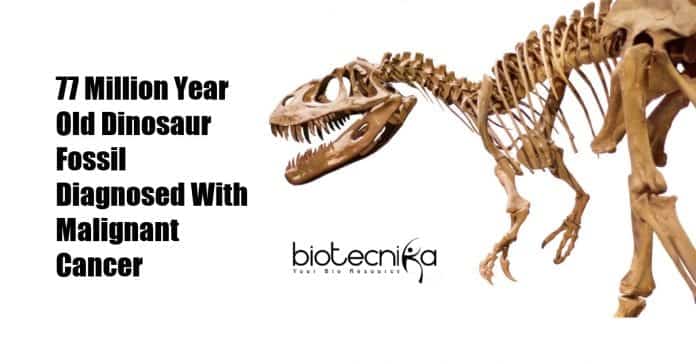Dinosaur Fossil With Bone Cancer Identified By Researchers
By combining the skills used to analyze prehistoric fossils with modern methods used to diagnose humans, a group of Canadian researchers has discovered the first confirmed case of a dinosaur with malignant cancer.
Malignant tumors, including bone cancers, are rooted quite deeply in the evolutionary history of organisms, suggested the study led by researchers at McMaster University in Hamilton, Ontario, and Toronto’s Royal Ontario Museum (ROM), which got published in the medical journal The Lancet Oncology on Monday.
The lower leg of centrosaurus apertus, a horned dinosaur that lived 76 to 77 million years ago, was examined by the researchers. The bone was retrieved in 1989 from one of the most dinosaur fossil-rich regions in the world, Dinosaur Provincial Park in southern Alberta, Canada, a UNESCO world heritage site.
The researchers noticed the visibly malformed bone on a trip to Alberta’s Royal Tyrrell Museum in 2017. They assembled a team of experts on both human and dinosaur pathology, including orthopedic surgeons.
Before diagnosing the dinosaur with osteosarcoma, the team performed high-resolution CT scans and examined the bone at the cellular level by slicing them into thin sections to investigate the cancer progression into
the bone. They compared the bone with a human bone with same cancer and with a regular fibula bone of the same species of dinosaur.
Osteosarcoma is usually found in teenagers and young adults and is the most common type of bone cancer in humans.
Since soft tissue is lost as the bones fossilized and they are often damaged in the process, it was previously difficult to establish the evidence of cancer in dinosaur fossils. Also, researchers were reluctant to destroy the bones for conducting tests, as dinosaur bones are rare and unique. Dr. Mark Crowther, a professor of pathology and molecular medicine at McMaster University, said that multiple levels of analysis and medical expertise were required to diagnose aggressive cancer like this in dinosaurs.
Dr. David Evans, a paleontologist at the ROM, said the cancer was advanced and aggressive in the dinosaur bone and would have made them crippling and vulnerable to tyrannosaur predators of the time.
The team hypothesized that the centrosaurus apertus might have survived longer than it normally would have with such a disease due to its place in a large, protective herd. And it is unlikely that cancer killed the dinosaur. The dinosaur would have died along with its large herd due to some other danger like a flood.






























